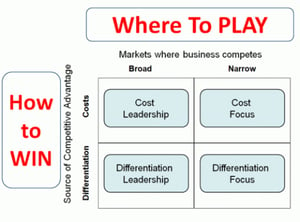 Your businesses Top Line Revenue Growth is a direct result of your Strategy-Decisions.
Your businesses Top Line Revenue Growth is a direct result of your Strategy-Decisions.
If you’re revenue is not growing year to year (if it’s not keeping pace with your industry), your Strategy decision-making needs improvement.
The past several blogs we’ve been exploring Strategy, through A.G. Lafley’s Playing to Win: How Strategy Really Works.
Previously we shared:
- What Strategy Is And Isn’t: Playing to Win
- PLAYING TO WIN – YOUR STRATEGY 5 CHOICES
- Strategy - What is Your Winning Aspiration?
- Strategy – Where to Play?
Where to play is half of the one-two punch at the heart of strategy. The second is how to win. Winning means providing a better consumer and customer value equation than your competitors do, and providing it on a sustainable basis.
Mike Porter first articulated the two generic ways of achieving this: cost leadership and differentiation.
Lafley points out the low-cost player isn’t necessarily the lowest prices. Low-cost players have the option of underpricing competitors, or to reinvest the margin differential in ways that create competitive advantage.
Mars is a great example of this approach. Rather than selling its bars at a lower price (which is nearly impossible because of the dynamics of the convenience-store trade), Mars has chosen to buy the best shelf space in the candy bar rack in every convenience store in America.
 Where to Play/How to Win
Where to Play/How to Win
There are four dimensions you need to think about to choose where to play and how to win:
- The industry. What is the structure of your industry and the attractiveness of its segments?
- Customers. What do your channel and end customers value?
- Relative position. How does your company fare, and how could it fare, relative to the competition?
- Competition. What will your competition do in reaction to your chosen course of action?
Most businesses understand their Industry. Customers, relative position, and competition are serious vagaries for most businesses. They think they do a good job. Seldom is supported by research. Here say, revenue growth, are false assumptions.
Once your business reaches $10 M in revenue you must understand your customers, relative position, and your competition. At $10 M your business is now on the radar of your competitors. To purchase, for competitive reasons, your differentiation, or simply because your ten million could be their $10 M.
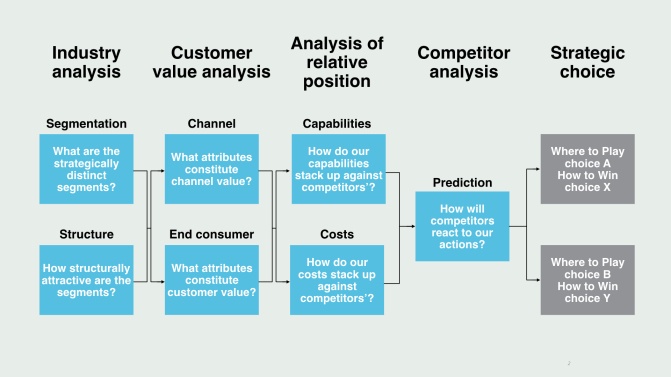 Multiple Ways to Win
Multiple Ways to Win
There is no one perfect strategy. None that will last for all time. There are multiple ways to win in any almost any industry. This is why building up strategic thinking capability within your organization is so vital.
That’s where growth businesses frequently fail. Their leadership team lacks this strategic thinking capability.
Where to start? Read ScaleUp, Playing to Win, and form a Strategic Advisory Council. Finally hire a coach to help who can help you craft your strategy. You can schedule an appointment with me here: https://meetme.so/DouglasAWick.
Strategic capability is required for thinking your way out of difficult positions. Strategy is a process. It’s the reason we’ve chosen Kaihan Krippendorff Outthink the Competition as a resource for our customers. And why we’re sharing ideas and methods from Playing to Win.
Low Cost vs Differentiating
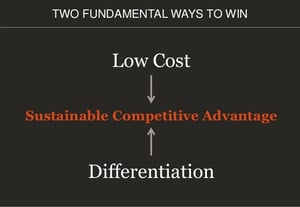 Your business must act consistent with you how-to-win choice. It’s vital. Lafley explains, “Cost leadership and differentiation have different imperatives that should lead to different sets of activities within a firm. Structuring a company to compete as a cost leader requires an obsessive focus on pushing costs out of the system, such that standardization and systemization become core drivers of value. Anything that requires a distinctive approach is likely to add cost and should be eliminated. In a differentiation strategy, costs still matter, but are not the focus of the company; customers are. The most important question is how to delight customers in a distinctive way that produces greater willingness to pay.”
Your business must act consistent with you how-to-win choice. It’s vital. Lafley explains, “Cost leadership and differentiation have different imperatives that should lead to different sets of activities within a firm. Structuring a company to compete as a cost leader requires an obsessive focus on pushing costs out of the system, such that standardization and systemization become core drivers of value. Anything that requires a distinctive approach is likely to add cost and should be eliminated. In a differentiation strategy, costs still matter, but are not the focus of the company; customers are. The most important question is how to delight customers in a distinctive way that produces greater willingness to pay.”
All companies make efforts to control costs. Here’s the key to Low Cost Strategy. There is only one low-cost player in any industry—the competitor with the very lowest costs. Lafley shares, “Having lower costs than some but not all competitors can enable a firm to stick around and compete for a while. But it won’t win. Only the true low-cost player can win with a low-cost strategy.”
One of my former customers was a Miller Coors distributor. Anheuser-Bush had the advantage in costs. To Win they needed to provide their customers with knowledge on pricing, merchandising, and margins. When developing their Strategy Statement, determining their Advantage was a challenging decision.
Reinforcing Choices
Where-to-play and how-to-win choices do not function independently; a strong where-to-play choice is only valuable if it is supported by a robust and actionable how-to-win choice. The two choices should reinforce one another to create a distinctive combination.
You don’t choose where to play and how to win and then move on. These two choices are intertwined and should be considered together: what how-to-win choices make sense with which where-to-play choices? And which combination makes the most sense for your organization?
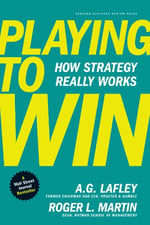 Bottom Line on Strategic Thinking
Bottom Line on Strategic Thinking
Lafley explains why Strategy is so crucial, “Both cost leadership and differentiation require the pursuit of distinctiveness. You don’t get to be a cost leader by producing your product or service exactly as your competitors do, and you don’t get to be a differentiator by trying to produce a product or service identical to your competitors’. To succeed in the long run, you must make thoughtful, creative decisions about how to win. In doing so, you enable your organization to sustainably provide a better value equation for consumers than competitors do and create competitive advantage.”
“Competitive advantage provides the only protection a company can have. A company with a competitive advantage earns a greater margin between revenue and cost than other companies do for engaging in the same activity. A firm can use that additional margin to fight those other companies, which will not have the resources to defend themselves. It can use that advantage to win. Low cost and differentiation seem like simple concepts, but they are very powerful in terms of keeping companies honest about their strategies.”
Lafley explains what I see as the Roadblock with most mid-size business, “Many companies like to describe themselves as winning through operational effectiveness or customer intimacy. These sound like good ideas, but if they don’t translate into a genuinely lower cost structure or higher prices from customers, they aren’t really strategies worth having. Across its categories and markets, P&G pursues branded differentiation strategies that allow it to command price premiums.”
Growth demands Strategic Discipline.
The 3 Strategic Disciplines: Priority, Metrics and Meeting Rhythms help your business dramatically improve your forecasting, and alignment. It empowers your team to achieve accelerated growth.
Strategy Decisions result in top line revenue growth. Positioning Systems helps you determine your best strategy for your future growth.
Positioning Systems helps your business achieve these outcomes on the Four most Important Decisions your business faces:
|
DECISION |
RESULT/OUTCOME |
|
PEOPLE |
|
|
STRATEGY |
|
|
EXECUTION |
|
|
CASH |
|
We help your business achieve Execution Excellence.
Positioning Systems helps mid-sized ($5M - $250M) business Scale-UP. We align your business to focus on Your One Thing! To achieve growth, you need to evolve in today’s rapidly changing economic environment. Are you avoiding a conversation with yourself on how to can successfully grow your business? Contact dwick@positioningsystems.com to Scale Up your business! Take our Four Decisions Needs Assessment to discover how your business measures against other Scaled Up companies. We’ll contact you.
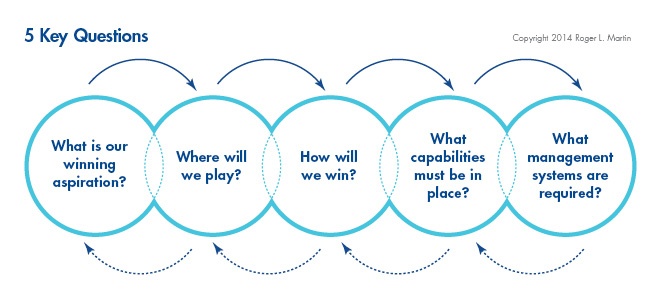 Next Blog – Strategy Step 4: Play to Your Strengths – Capabilities
Next Blog – Strategy Step 4: Play to Your Strengths – Capabilities
An organization’s core capabilities are those activities that, when performed at the highest level, enable the organization to bring its where-to-play and how-to-win choices to life. Does your organization know your strengths, your core capabilities? In my experience, most business don’t. Let’s discover how your distinctive strengths need to support your strategy next blog.






.jpeg?width=150&height=135&name=Hand%20with%20marker%20writing%20the%20question%20Whats%20Next_%20(1).jpeg)

